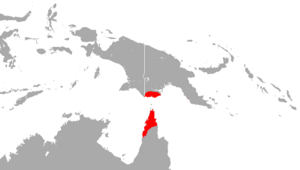Papuan sheath-tailed bat facts for kids
Quick facts for kids Papuan sheath-tailed bat |
|
|---|---|
| Conservation status | |
| Scientific classification | |
 |
|
| Papuan sheath-tailed bat range |
The Papuan sheath-tailed bat (Saccolaimus mixtus) is a type of bat that lives in the Cape York Peninsula in Australia and in New Guinea. This bat is not very well known. It hunts for insects that fly at night, usually in open forests.
Contents
About the Papuan Sheath-Tailed Bat
Who Discovered This Bat?
The Papuan sheath-tailed bat was first officially described in 1925. A scientist named Ellis Le Geyt Troughton wrote about it. He noticed that this bat had special pouches on its wings. These pouches are a key feature of its group.
Troughton studied some bats that were bought in 1878 from Port Moresby. He also looked at notes from another scientist, Edward P. Ramsay, who had seen similar bats. The name mixtus means "mixed" or "intermediate" in Latin. This name was chosen because the bat has features from different groups.
Other Names for This Bat
This bat has a few different common names. It is often called the Papuan sheath-tailed bat. Another name is Troughton's pouched bat, named after the scientist who discovered it. In Australia, it is sometimes called the Cape York sheath-tailed bat. You might also hear it called the New Guinea sheathtail bat or wing-pouched saccolaimus.
What Does the Papuan Sheath-Tailed Bat Look Like?
This bat is a species of Saccolaimus. It has dark, grayish fur on its back. The fur is darkest on its head and shoulders. Its belly is a lighter, pale gray color.
Size and Features
The Papuan sheath-tailed bat is a medium-sized bat. Its forearm, which is part of its wing, measures about 62 to 68 millimeters (about 2.4 to 2.7 inches). Its head and body together are about 72 to 77 millimeters (about 2.8 to 3 inches) long. This bat usually weighs around 24 grams (less than an ounce).
Its ears are about 18 millimeters (about 0.7 inches) long. The bare skin on its ears, nose, and face is dark brown.
Special Pouches
One interesting feature of this bat is its pouches. It has a pouch on its wing, which is lined with whitish hairs. It also has a pouch on its throat. This throat pouch is very noticeable in male bats. In female bats, it looks more like a bare patch of skin.
How to Identify Them
These bats make sounds that are too high for humans to hear, but the first part of their call can sometimes be heard. Scientists record their calls at 9 kilohertz. This helps them tell the Papuan sheath-tailed bat apart from other similar bats.
When flying, you can tell them apart by their fast wing beats and their size. Their light-colored belly also helps identify them. They look a bit like the Saccolaimus flaviventris. However, the yellow-bellied bat is bigger and has darker fur. Female yellow-bellied bats also have a more developed throat pouch.
Where Do Papuan Sheath-Tailed Bats Live?
Their Home Range
The Papuan sheath-tailed bat lives in northern Australia and the southwest part of Papua New Guinea. In Australia, they have been found in a few places in Cape York. This includes areas near Weipa and Pascoe River.
Their Habitat
In western Queensland, Australia, these bats like to live in forests. These forests are often filled with a type of tree called Eucalyptus tetrodonta. The bats have been seen living in small groups inside dead parts of these trees.
Most of what we know about their daily lives comes from observations in New Guinea. There, they often rest during the day in limestone caves. At night, they fly and hunt for food above the forest canopy. In Australia, they prefer to rest in hollows inside trees during the day.
They seem to enjoy hunting over the tops of trees. They also like to fly in open areas, such as over streams and clearings. Recent studies suggest they might live in an even wider area than first thought. This includes southern and western parts of Cape York and some islands to the north. They have also been reported in Pormpuraaw, Queensland.
Protecting the Papuan Sheath-Tailed Bat
Conservation Status
The IUCN is a group that checks on animals around the world. They have listed the Papuan sheath-tailed bat as "near threatened." This means their numbers are going down. In 2017, they changed its status from "data deficient" (meaning not enough information) to "near threatened."
Threats to Their Survival
One of the biggest threats to these bats is habitat loss. In Australia, their homes are threatened by mining for bauxite. Also, fires that are not managed well can harm their habitat.
In New Guinea, scientists have not fully checked the effects of land clearing. However, a lot of land clearing happens around Port Moresby, where these bats were first found. This could be a big problem for them. The government of Queensland, Australia, currently lists this bat as "least concern" in their state.
See also
 In Spanish: Saccolaimus mixtus para niños
In Spanish: Saccolaimus mixtus para niños


